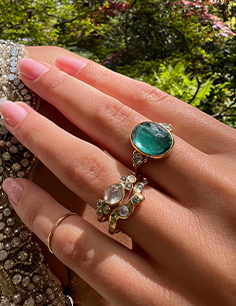The Ultimate Guide to Opal Jewelry

Opal is truly one-of-a-kind. Diamonds may be a girl’s best friend, but opal is her soulmate.
How could anyone resist those earthy, vibrant hues of teal, yellow, pink, and blue? They come in so many variations; some are bright and elaborate like rainbows; some are white and freckled with color like fallen snow; some are delicate and subdued like frosted pastels; some are dark and mysterious like glittering lava. The possibilities go on and on!
But what is opal, exactly?
Unlike other gemstones with similar properties, opal isn’t a crystal. It doesn’t have the kind of perfect structure you find in diamonds or in zoomed-in photos of snowflakes.
Rather, it’s a form of silica, a natural material found in stone, soil, and sand. Flowing water picks up silica over time and then deposits it into the cracks of rocks and other surfaces, where it eventually dries out. Once the water has completely evaporated, we’re left with stunning and unpredictable patterns of silica that make opal! That’s why the variations of Australian opal jewelry available are so unique.
Where Does Opal Come From?
Most of the world’s opal comes straight from Australia – nearly 97%, to be exact.
The “Opal-Mining Capital of the World” is a remote town called Coober Pedy in South Australia. About 125 million years ago, the area was an inland sea, the perfect place for silica deposits to mix with water and fill the crevices of the rocks below.
A majority of the opal in our shop comes from this region of Australia, which delivers a stunning array of opal jewelry options. However, since silica is such a common mineral, opal deposits can be found all over the world! In strong competition with Australia is Ethiopia, but other competitors include Mexico, parts of Europe and the US, Indonesia, and South America.
Along with cuts from Australia, our shop includes these unique 14k opal rings from Indonesia and Peru.
How Opal Jewelry is Valued
To get an idea of the value of opal, consider this: The most expensive type of opal in the world is black opal, which can be valued at an estimated $10,000 per carat! To compare, most diamonds are valued anywhere from $1,300 to $16,500 per carat.
Still, opal remains a popular jewelry choice, as it can be found at far lower prices than any of the above. Opal value is based on these main factors:
Color
What is that incredible, rainbow-like pattern that you find in opal? It’s called “play-of-color,” and it comes from light entering the complex internal structure of the opal and bouncing around in all directions. This splatter of prism light can appear in an unlimited number of variations, but it is most valuable if red is included, especially if that red appears directly next to blue. The background color is also important, valued most when it’s dark, and shows off the spectacular play-of-color.
Pattern
The way play-of-color comes together is called a pattern. In opal, you may find a peacock pattern with main spots of green and blue, a flame pattern with added red spots, a pinfire pattern with tiny, concentrated pinpoints of color, or a mosaic pattern with big sections of color throughout. A mosaic pattern is preferred, with colors that are clearly distinct from one another.
Transparency, Clarity, and Inclusions
Opal transparency ranges from completely transparent to completely opaque. The more transparent, the higher the value. Opal clarity can be affected during the drying process by factors like crazing, which are unsightly fractures that lower a stone’s worth. Inclusions are just as they sound – microscopic materials that are included in the opal, such as crystals, organic matter, or air bubbles. The less visible the inclusions, the more valuable the opal.
Additional Factors
Of course, there are many additional factors that can impact an opal’s worth, such as color brightness, country of origin, rarity, shape, and whether or not the opal has been altered or treated. While some opals are cut in geometric shapes like rectangles and triangles, most are cut in organic dome shapes, which are the strongest, most durable option due to the stone’s porous nature. Both geometric and organic opal shapes can be found in our shop.
Opal Jewelry Variations
There are countless types of opal in the world, but these are considered the most common:
Black Opal – Dark with strong play-of-color.
White Opal – White or gray with strong play-of-color.
Crystal Opal – Transparent to semi-transparent with strong play-of-color.
Water Opal – Similar to crystal opal, except little to no play-of-color.
Fire Opal – Fiery colors, either transparent or opaque with or without play-of-color.
Boulder Opal – Unique striped opal found in boulders.
Rainbow Opal – Rare fluorescent opal with multiple colors.
For an extraordinary rainbow and boulder combo, view this stunning opal ring from our shop!
We love to pair our opal with unique accent stones such as emerald, pink sapphire, diamonds, rhodolite garnet, and even other forms of opal. Of course, the opal itself makes a great accent stone for rose quartz, turquoise, and pink tourmaline, all of which are included in our shop.
Remember how opal is formed by running water? It can also be re-formed by running water, so avoid wearing your opal rings while washing dishes or taking a swim!
Due to their bewitching nature, opal has been surrounded by superstition throughout history. Some say it’s lucky, others say it’s unlucky, and some even say it has healing powers. Don’t forget that opal is the official birthstone for the month of October, making it the perfect gift for any Libras in your life! Shop opal jewelry and add some play-of-color to your day.









